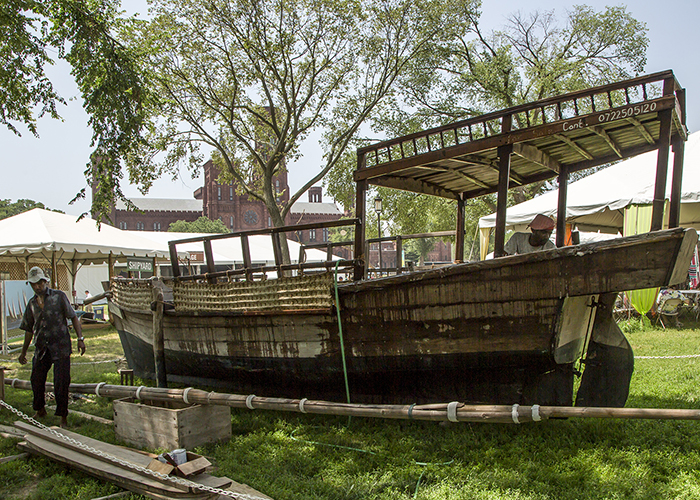Madeleine at the Museum: Navigation and Fashion Traditions

Throughout the 2014 Smithsonian Folklife Festival, events took place on and off the National Mall. While each were fun, informative, and exciting, the related events in various Smithsonian museums allowed you to sit in the air-conditioning for a bit and take in wonderful stories from our participants in a more formal setting.
During the last week of the Festival, I set out to learn more about Kenya and its traditions off the Mall.
Navigation and Tradition
First I headed over to the National Air and Space Museum’s Albert Einstein Planetarium for a session about traditional Swahili navigation with master carver and dhow builder Ali Skanda. If you don’t know Ali Skanda already, you might have seen him renovating his thirty-foot Kenyan sailboat Lamu on the National Mall over the two weeks.
Ali has not only continued his family’s legacy of dhow building, sailing, and wood carving in Lamu, Kenya, but also traditional navigation. With the help of the starry sky projected onto the Planetarium ceiling, he demonstrated how generations of sailors look to the sky for inspiration, meaning, and direction. To Ali, “the sky has the purpose.”
Fashion and Respect

Next I went to the National Museum of African Art for a workshop called “Khanga Stories,” where we learned about the colorful Kenyan cloth. One of the presenters, Abdulhamid Muneeb Kaderdina, has been involved in khanga design, production, and marketing at his family’s 130-year-old business his whole life.
While khangas usually came in two pieces and were traditionally worn as hijabs by women in Kenya, they have evolved into a versatile cloth used as a fashion statement by many women and men all over East Africa. While demonstrating how women utilize khangas to carry water on their heads and their children on their backs at the same time, Muneeb commented, “In Africa, we have very strong women.”
The three parts to the khanga—the border, central design, and text—combine to create a strong, useful, and meaningful piece of cloth to many Kenyan women. The khanga has also become a sign of respectability. As another presenter explained, “You cannot be completely female without it.”
These two events demonstrated to me two overarching themes of the Festival: tradition and evolution. There is tradition in dhow making and sailing, just as there is tradition in representing oneself with the khanga. Most importantly, however, the participants and their families have kept these traditions alive while evolving to keep them new or use them in a modern context.
Since many of us may never get a chance to visit these wonderful places, we are so thankful to all the participants who came to share with us and give us a small glimpse of the diverse and dynamic traditions that make their countries so wonderful.
Madeleine Yoder is the social media intern at the Center for Folklife and Cultural Heritage, a music and sociology student at Goshen College in Indiana, and a big fan of the Folklife Festival.

